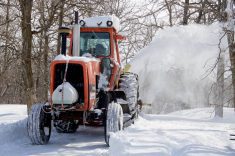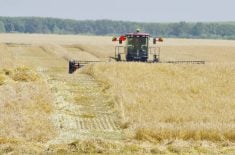Overview
Harvest progress sits at 95 per cent complete across the province.
Harvest is wrapping up or done in most parts of southern Manitoba, and significant amounts of fall fieldwork, and surface drainage cleanout have been completed. Fall fertilizer application is generally behind last year’s pace.
Read Also

Seeding Indigenous agricultural prosperity
National Circle for Indigenous Agriculture and Food says Indigenous agricultural success needs strong relationships.
Fall anhydrous ammonia application continues as soils cool, but rainfall over southern Manitoba over the weekend has stopped until soils dry slightly or the winter applicant ban takes effect.
No provincial variance is in effect for the restriction on winter nutrient application on or after November 10, 2022, based on the Nutrient Management Regulation.
Topsoils (0-30 cm) remain dry to very dry in large parts of western and central Manitoba, and more moisture is needed to help seal in applied fertilizer and recharge available soil water for the 2023 crop. Soils in the Interlake and Eastern regions are wetter, and are stalling corn harvest and fieldwork.
Corn harvest ongoing, and is most advanced in the Red River Valley of the Central region. Yields there are reported between 150 to 200 bu/acre on average, and between 120 to 150 bu/acre in the Southwest.
Cereals
Spring cereal grains
The cereal crop harvest is considered complete, with the rare wheat or oat field remaining across Manitoba.
Wheat yields have been better than expected, between 40 to 85 bu/acre, averaging close to 60 bu/acre for many farms.
Corn
Harvest is most advanced in the Red River Valley, and post-harvest tillage has been rapid. Harvesting speed is limited by favourable weather and grain drying capacity at this time.
Corn yields from the Central region have been very good, all reports are above average at 150 to 200 bu/acre, and seed moisture dropped rapidly with warmer days last week.
Yields in the Southwest region are between 120 to 150 bu/acre, and seed moisture is in the high teens to low twenties.
Corn yields in the Eastern region are ranging from 145 to 175 bu/acre, but farmers there have not yet harvested a substantial number of acres to build a reliable average report.
Oilseeds
Canola
Harvest advanced toward completion in canola this past week, with most areas finished, while local districts in the Southwest region north of PTH 16 still have a number of fields to combine.
A few canola crops remain on the field in the Northwest and Interlake regions, primarily where very late seeding or hail/weather delays slowed crop growth.
Flax and sunflowers
A few flax fields remain unharvested in the Southwest and Northwest regions, while most flax crops are harvested across the province.
The provincial flax crop is expected to be near or above the record average yield per acre.
Sunflowers harvest is in several stages, depending on region and local district. Some farms are finished, while others are waiting for the crop to dry down again after this past weekend’s rain. Poor field conditions after the rains may push back harvest several days or more.
Sunflower yields have been average to above average, with more plump kernels and fewer empty shells than in 2021. Average yields are between 2,000 to 2,300 lbs/acre.
Pulses
Soybeans
Soybean harvest is virtually complete in all regions, and yields have been better than expected in most parts of the province. Crop quality remains high, and good harvest conditions allowed for speedy harvest and low earth tag.
Average soybean yield across Manitoba is predicted to reach 45 bu/acre, surpassing the previous record of 42 bu/acre set in 2016.
Early-season soybeans were yielding between 40 to 50 bu/acre, while long-season soybeans were yielding 50 to 65 bu/acre, both with good crop quality.
Soybean yields vary widely in the Northwest, from 20 to 60 bu/acre, with approximately half the crop harvested there.
Forages and livestock
Forages
Grass hay and alfalfa has gone dormant and grazing supply is low. Cattle remaining on pasture are being supplemented with baled hay.
Corn silage yields have been excellent across the province, from 14 to 20 tonnes/acre, averaging 16 tonnes/acre.
Retrieval and removal of hay and straw bales is underway, leaving some fields rutted in regions where rainfall was higher this past week.
Initial feed quality tests from the Eastern region show a 10 to 15 per cent reduction in feed energy value compared to last year, though hay volumes are substantially higher.
Livestock
Dugouts and sloughs are at 70 per cent capacity in the Southwest, and are beginning to freeze over each morning.
Cattle are being rounded up from pastures, and are being brought home or to winter feeding sites.
Producers are actively hauling manure from pens onto fields, and moving feed into yards for winter.
Spring calves are being weaned, and bulls have been turned out with the cows for several weeks.
Stock yards are seeing increased activity with some liquidation occurring while prices remain firm.
Coyote populations have been noted by some ranchers as increasing, more animals are visible during daylight hours.
Regional comments
Southwest
Above-seasonal daytime temperatures began last week, allowing those with unharvested crop remaining to finish up. Cooler weather arrived towards the weekend, and substantial rains (15 to 25 mm) fell across the region Sunday to Monday evening. While rainfall stopped the remaining harvest and fieldwork, moisture was necessary to help reduce dry soil issues with fertilizer banding and tillage, as well as improve outlook for winter cereals. Field residue burning has been limited this year.
Northwest
Mixed weather carried into the week, warmer days starting last week, becoming colder with high humidity and small amounts of precipitation by the weekend. Harvest is virtually complete for all crops, with the exception of silage corn awaiting custom chopping crews on the eastern side of the region. Higher tonnage losses from black bear damage were noted this year. Fall fertilizer application has seen good progress, and farmers are continuing to band anhydrous ammonia and granular fertilizer as weather permits until the nutrient application deadline. Post-harvest herbicide application is wrapping up with successive killing frosts.
Central
Frosty nights and strong winds over the past week have aided crop dry down considerably. Fall field operations over the past week harvest has progressed efficiently with the few remaining cereal, oilseeds and pulse crops were harvested. Corn harvest is around 30 per cent for the region, sunflower around 25 per cent. Extensive fall field operations including tillage, fertilizer applications, ditching, and tile drainage were undertaken across the region over the past week.
Rainfall beginning Sunday evening through Monday prevented further harvest of remaining sunflowers and corn, as well as field operations. Heavier clay soils, especially along the Red River may not be able to support machine traffic until the weekend, but lighter soils see a resumption in field activity mid-week. Farmers will be hoping for a few dry weeks to allow for harvest to progress and for continued field operations in November until the nutrient application deadline. If field conditions improve next week, corn and sunflowers in the region will be completed harvest within two and a half weeks. Farmers are confident that this is possible with given forecast.
Eastern
Rainfall amounting between 7 to 20 mm fell across the region yesterday. A small window of ideal harvesting weather last week pushed farms to harvest as fast as possible. Weather deteriorated towards the weekend with intermittent drizzles putting a stop to harvest, haying and field work. Steady rain yesterday led to standing water by Monday evening. Harvest emphasis was on soybeans as they were drying down the most effectively. Aeration bins and driers are necessary for grain conditioning, and stored grain monitoring is ongoing.
Most farms have only field work and fertilizer application remaining to do this year. Farms that have maintained soil phosphorus and potassium levels are taking advantage of a lower input bill for the 2023 crop, while those that have not are facing steep costs for next year, or are choosing to overlook.
Interlake
Harvest is nearly complete, with the regional harvest percentage sitting at 90 per cent done. There was only a slight advancement in harvest progress compared to last week. Corn makes up the majority of the remaining unharvested acres. Rainfall over the weekend brought up approximately 20 mm to the region, slowing field activities. Some tillage and fertilizer application was finished in the region, while there are a substantial number of unworked acres in the northern Interlake around surrounding Arborg.















